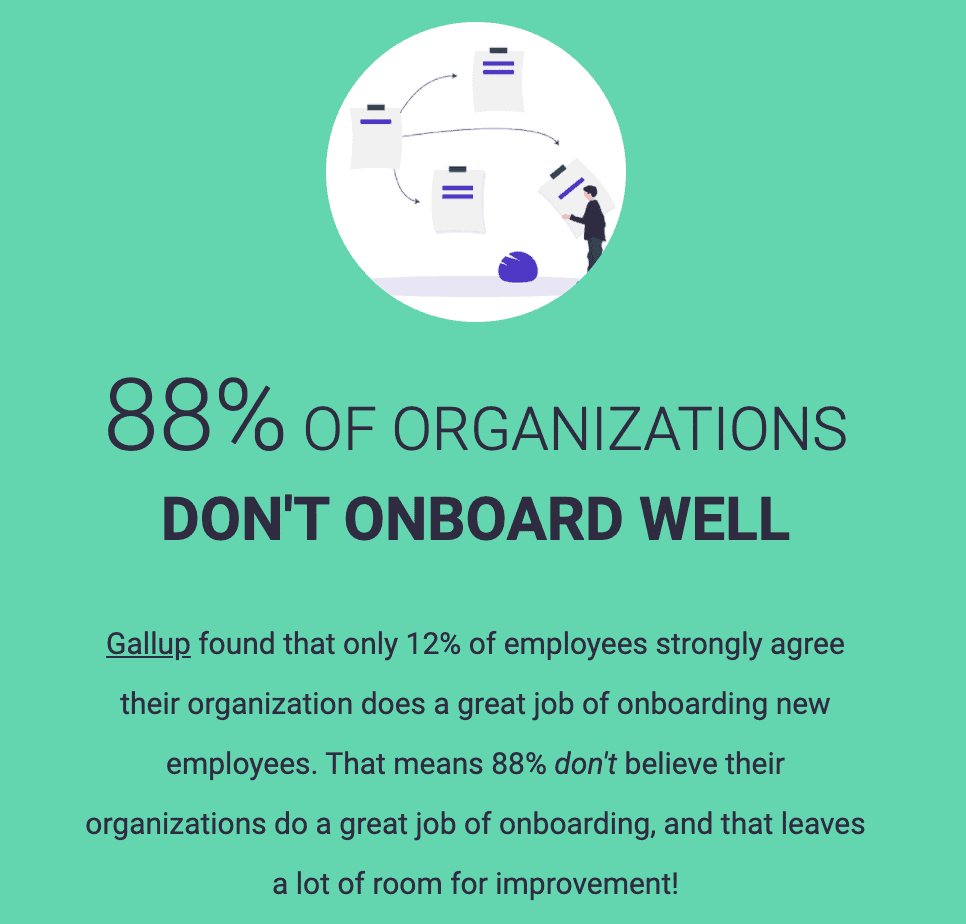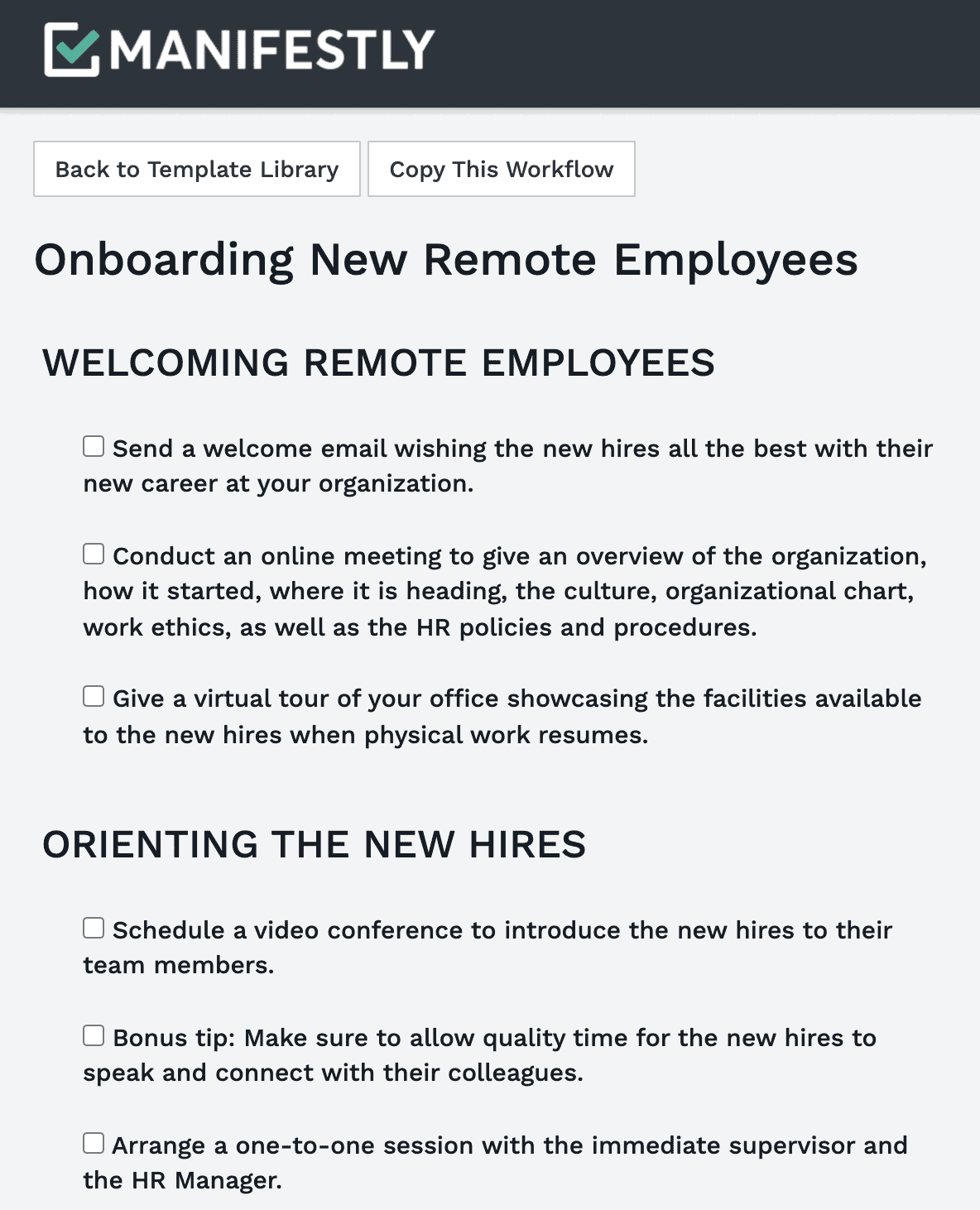Want to skip the article and jump right in? Here is our Onboarding Remote Employees checklist.

A recent survey by Glassdoor discovered that out of the employees who have undergone a successful onboarding process, 91% feel more connected at work, while 89% find it easy to integrate with the company culture.
Gallup finds that only 12% of employees strongly agree that their organization does a great job onboarding new employees. Twelve percent!!!
According to the data published by The Society for Human Resource Management, organizations with a well-structured onboarding process are likely to experience 50% greater productivity in newly hired employees. Findings also reveal that nearly 70% of employees are likely to continue their service for 3 years, in a company where the onboarding experience is awesome.
And while employee onboarding is normally taxing to your organization as well as the employee being onboarded, remote onboarding is even more taxing for new employees.
Want to learn more? Here are 33 onboarding statistics.
Employee onboarding workflows are a key aspect of employee resourcing and involves all the processes employed in integrating the new hires into the company strategy and culture. This is a broader concept compared to employee induction where new employees are introduced to the organization.
Employee onboarding can be a labor-intensive process that has become even tougher with the current pandemic situation and the shift to more remote work. Hence, it takes special processes, tailored to the human resource checklist needs of remote workers to ensure that the new hires feel a connection to your team, even when they are remote, and are able to adjust to the work and social environment of your organization smoothly and quickly.
The best way to do this is to have dependable workflows and checklists in all phases of the onboarding process. There’s nothing worse for a new hire than to experience holes and “dropped balls” during their onboarding process – it instills a lack of confidence in the organization and if it happens too much, mistakes in onboarding will contribute to employee turnover.
The key here is to ensure that new hires feel connected and valued by the team from day one. So, reinforce how excited your organization is to have the new hires on your team and make sure that their tasks require collaboration with multiple teams.
The more engaging the orientation program is, the more new hires retain information shared during the process. While virtual methods could be as effective as the conventional onboarding process, a thoughtful and methodical onboarding plan can help avoid frustrations and potential technical barriers such as network breakdowns.
This checklist covers the fundamental elements of employee onboarding that are required to onboard and engage remote workers successfully.
Prior to the First Day at Work

One of the greatest challenges HR Managers encounter in onboarding new hires is how to make them feel like a part of the organization. This becomes even tougher when onboarding remote workers through virtual means without any physical presence. To overcome this barrier, it is prudent to commence the onboarding process as early as possible so that the new hires get ample time to adjust themselves to the culture and the work-from-home procedures of your organization.
Starting early would also facilitate proactive identification of any hindrances and obstacles to commencing remote work. For this, it is crucial to encourage the new hires to ask questions and share their concerns. In fact, constant communication is the key to building a professional rapport with the newly hired remote workers while also making them feel connected to the team.
The following checklist will guide you in planning the initial stage of the remote worker onboarding process effectively. It also shares tips and strategies to elevate the excitement of the new hires.
PLANNING THE ONBOARDING PROCESS
- Devise goals and objectives for your remote induction program and plan the tasks accordingly.
- Decide how long the onboarding process would last and who should be involved in the process.
- Create a simple yet comprehensive agenda for the orientation program.
- Bonus tip: When devising the agenda, it is recommended to include breaks in between each session so that the new hires would not find it overwhelming.
- Get all the presentations and materials for the program ready with appropriate and interesting visuals and videos.
Collaborate with the IT department to enroll the new hires in the organization’s systems and applications. - Get the office supplies, equipment, and other resources that need to be sent to the new hires ready and make sure they are functioning properly.
START EXECUTING THE PLAN
- Send an informative email including everything that the new hires should know prior to their first day at work.
- General information about the organization such as the vision, mission, values, the type of products or services offered, past and upcoming projects.
- Information that is specific to the new hire such as the details of the insurance covers, medical facilities, access to courses and other learning opportunities, daycare facilities, and other company-sponsored benefits.
- Attach a digital copy of the employee handbook.
- Reiterate the information communicated via email through a phone call and address any concerns.
- Deliver all necessary equipment such as a laptop, phone, router, printer, etc.
- Bonus tip: It is a great idea to send some work essentials such as a personalized notebook, set of pens, a mug, etc. as a means of boosting the spirit of the new hires and making them feel valued.
- Get the employee verification for receipt of office equipment and supplies in good condition.
- Support the remote employees to set up a productive workspace that is free of any disturbances.
- Share the email address and the login credentials for the company intranet, remote worker software and any other required information systems.
- Add the new hires to the right email groups and chat groups.
- Send supporting documents that enhance the job productivity such as a work calendar/planner, a digital diary, a checklist of tasks.
- Send your agenda for the first day along with the links to join the video conferences.
- Bonus tip: Include the contact details of your IT support team, so that the new hires could rectify any technical issues during the meeting.
- Communicate to the rest of the team about the start date of their new team member and motivate them to be supportive and available for any queries raised by the new employee.
On the First Day at Work
Orienting new hires to the organization should be done in a systematic and professional manner as this may have a significant impact on their first impression. To make the induction program productive, it is highly advisable that you encourage two-way communication between the new hires and the organization.
Not only should it be interactive, but it also should be interesting, thereby stimulating the new employees to fulfill their virtual job duties and tasks successfully. Besides, the orientation program needs to be informative to facilitate the new hires to undertake their responsibilities at work much more confidently.
The following checklist will assist you in planning a pleasant and cordial welcome to the newly hired remote employees.
WELCOMING REMOTE EMPLOYEES
- Send a welcome email wishing the new hires all the best with their new career at your organization.
- Conduct an online meeting to give an overview of the organization, how it started, where it is heading, the culture, organizational chart, work ethics, as well as the HR policies and procedures.
- Give a virtual tour of your office showcasing the facilities available to the new hires when physical work resumes.
ORIENTING THE NEW HIRES
- Schedule a video conference to introduce the new hires to their team members.
- Bonus tip: Make sure to allow quality time for the new hires to speak and connect with their colleagues.
- Arrange a one-to-one session with the immediate supervisor and the HR Manager.
- Bonus tip: The initial meeting could focus on understanding the new hires better so that the orientation program could be customized to enhance its effectiveness.
- Review the onboarding schedule with the new hires to ensure they are prepared for it.
- Discuss the career objectives, communication preferences, working styles, and the challenges faced by the new hires.
- Explain the sources of support available to the new employees to perform their job successfully along with their contact details.
During the First Week at Work
While the new employee gets accustomed to the culture and practices of your organization, you can start training and gradually delegate responsibilities. This would not only make their first-week productive but will also prepare them to execute their duties successfully.
Optimize your remote employee onboarding process with the checklist below.
ROLE CLARIFICATION
- Clearly explain the tasks, duties, and responsibilities of the remote work position.
- Introduce the first assignment and give them a chance to attempt simple tasks.
- Bonus tip: Start with simple assignments and go over them step by step. This will make them more doable and interesting, thereby uplifting the confidence of the new hires.
- Communicate precisely what your organization expects from the new hires.
NEW HIRE TRAINING
- Commence the online training sessions to enhance job-related knowledge and skills.
- Bonus tip: You can get different organizational members to conduct the training so that the new employees would not get bored. This would also grant the new hires an opportunity to meet and interact with different employees.
- Provide specific tasks to complete at the end of each training program with the opportunity to receive feedback from the trainer.
During the First Month at Work
Once the newly hired remote workers are familiar with their job duties, you can start assigning more challenging tasks. For instance, involving the new hires in urgent projects and in the company’s decision-making. Surely, this would give them a valuable opportunity to exhibit their talents. Also, it is vital to give sufficient recognition for task accomplishment in order to encourage consistently great performance.
The following checklist provides a framework for the onboarding process during the first month at work.
TASK DELEGATION
- Assign work to the new hires with deadlines to complete.
- Provide a comprehensive and precise overview of the performance review process including the measurement criteria and the Key Performance Indicators (KPIs).
- Assign a mentor to support the new hires with job-related tasks and to address any challenges they might face in adjusting to the organization.
- Devise a networking plan that matches the personality of the remote employees. Below are some ideas that you can consider.
- An in-person event with the team such as a dinner, or a coffee out.
- Virtual team-building games.
- Job rotation across departments.
PERFORMANCE APPRAISAL
- Have regular manager check-in meetings to examine and assess the new hires’ job fit and organizational fit.
- Communicate the impact that new hire’s responsibilities have on the organizational outcomes.
- Have a formal interview to provide constructive feedback to the new hires and to review the performance objectives.
After Onboarding Remote Employees
Once the onboarding process is completed, it is a good practice to assess the effectiveness of the process. This will enable your organization to identify the weaknesses of the current onboarding process and thereby devise an action plan to rectify those in the future.
While such a review is often underestimated in many organizations, the following checklist will guide you with the best practices in the final stage of onboarding employees.
- Critically examine your onboarding process with your original plan and against the organizational goals and objectives to identify any deviations.
- Get feedback from the new hires concerning all aspects of their onboarding experience.
Bonus tip: Include open-ended questions in your survey so that you can get valuable insights on what you are doing well and how the process can be improved. Also, it is prudent to get the feedback anonymously so that the new hires would not hesitate to share their feelings and opinions openly. - Incorporate the responses into your onboarding process and update the HR policies of your organization.
Wrapping Up
Onboarding employees in a remote setting has never been an as easy task for HR Managers. In fact, it is challenging to ensure that the new hires are productive, engaging, and satisfied at the same time. Hence, it is strongly recommended to have a planned approach to onboarding remote workers that takes into account the personality of the new hires, their preferences, and the learning curve. However, it is equally important to be flexible and make adjustments to the onboarding plan when needed.
A successful onboarding process is an amalgamation of team building, training, and performance review initiatives. The diverse activities you arrange to make the onboarding process interesting should not dwindle after the process is completed. Rather, they should be integrated into the company strategy and culture and thereby facilitate in retaining and bolstering the interest of the new hires.
You can find this HR Checklist for Onboarding Remote Employees in the Human Resources workflow checklist templates section of Manifestly.



